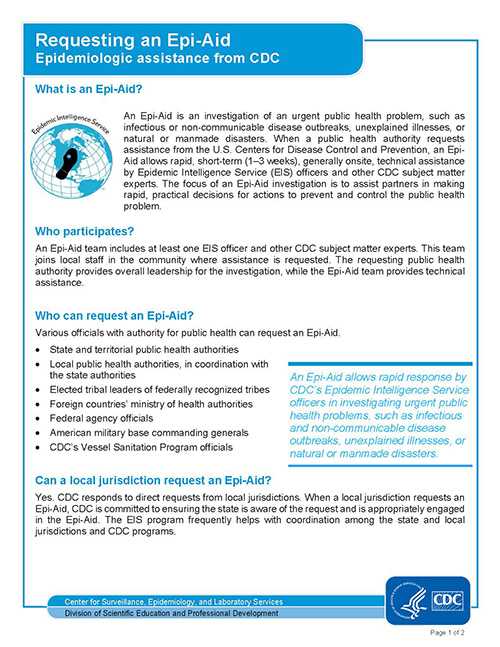Epidemiologic Assistance (Epi-Aids)
Epi-Aids are the cornerstone of experiential training for EIS officers. An Epi-Aid is a mechanism for public health authorities to request the short-term epidemiologic assistance of EIS officers to respond to an urgent public health problem.
“In my first year as an EIS officer, I have tracked Ebola cases in Sierra Leone, worked to better understand giardiasis surveillance in the U.S., released emergency botulism antitoxin stores to U.S. hospitals, and helped launch a study to improve water supplies in rural Kenya.”
Katie Curran, PhD, EIS Class of 2014
Public health authorities must invite CDC to assist in an epidemiologic investigation within their jurisdiction. Requests for Epi-Aids can come from:
- State epidemiologists
- Tribal chiefs
- Commanding generals (American military bases)
- Ministers of health (foreign countries)
- Federal agencies
- CDC’s Vessel Sanitation Program
Through Epi-Aids, EIS officers apply epidemiologic methodology to investigate:
- Unexplained illnesses
- Occupational injuries
- Infectious disease outbreaks
- Post-hurricane effects
- Other public health threats
The accompanying Epi-Aid fact sheet provides procedures for public health authorities to request an Epi-Aid.
In FY 2014, Epi-Aids were requested by:
- 34 states and territories
- 3 tribal organizations
- 2 federal agencies
- 15 countries
EIS officers participating in Epi-Aids recently:
- Assessed the effectiveness of a vaccination campaign for preventing meningococcal disease in 25,000 University of Oregon students
- Identified 37 potential methyl bromide exposures in the Virgin Islands
- Trained 22 clinicians on monkeypox recognition and control in the Democratic Republic of the Congo

EIS officer drags for ticks at Gettysburg Military Park during a Lyme disease investigation.

EIS officer studies a map of West Africa during the 2014 Ebola outbreak.
- Page last reviewed: February 21, 2017
- Page last updated: February 21, 2017
- Content source:



 ShareCompartir
ShareCompartir
